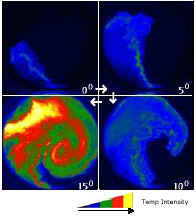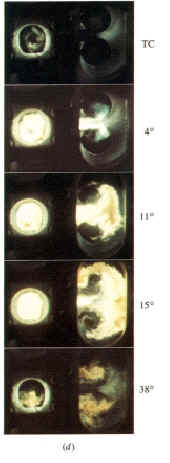Just like regular fluid flows, flame propagation can be grouped into laminar and turbulent categories. The character of a flame can even be quantified using Reynolds numbers. The exact science of assigning a flame a Reynolds number is not really within the scope of this report, so the discussion here will center on qualitatively defining the character of the flames. Laminar flames are steady and tend not to move much. Candles tend to have laminar flames. A Bunsen burner flame is another common laminar flame.
Unpredictability is one of the main characteristics of turbulent fluid flow. This trait carries over to turbulent flame propagation as well. Turbulent flames are unsteady and random. A common example of a turbulent flame is a campfire.
 |
 |
| Laminar | Turbulent |

